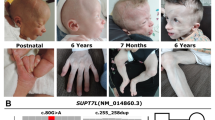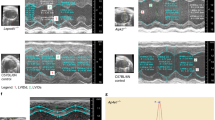Abstract
The object of the study was to elucidate the mutations of the GATA4 gene in Han ancestry patients with congenital cardiac septal defects. Fifty Han ancestry patients with sporadic and familial cardiac septal defects and 200 normal subjects of the same ethnical background were studied. A total of six exons and the intron–exon boundaries of GATA4 were amplified by polymerase chain reaction (PCR). The PCR products were purified and directly sequenced with an ABI PRISM 3730 Automatic DNA sequencer. Two novel heterozygous mutations were discovered in the GATA4 gene in five children with cardiac septal defects (10%, 5/50), His28Tyr in exon 2 and His436Tyr in exon 7, respectively, which were neither found in the control population nor reported in the SNP database at the website http://www.ncbi.nlm.nih.gov/SNP. In addition, we did not identify any mutations in GATA4 in three familial atrial septal defects and two familial ventricular septal defects. Our finding suggests that the mutations in the transcription factor GATA4 might be related to congenital cardiac septal defects in Han ancestry patients.


Similar content being viewed by others
References
Benson DW (2002) The genetics of congenital heart disease: a point in the revolution. Cardiol Clin 20:385–394
Ching YH, Ghosh TK, Cross SJ, Packham EA, Honeyman L (2005) Mutation in myosin heavy chain 6 causes atrial septal defect. Nat Genet 37:423–428
Clark KL, Yutzey KE, Benson DW (2006) Transcription factors and congential heart defects. Annu Rev Physiol 68:97–121
Durocher D, Charron F, Warren R, Schwartz RJ, Nemer M (1997) The cardiac transcription factors Nkx2.5 and GATA4 are mutual cofactors. EMBO J 16:5687–5696
Gajewski K, Fossett N, Molkentin JD, Schulz RA (1999) The zinc finger proteins pannier and GATA4 function as cardiogenic factors in Drosophia. Development 126:5679–5688
Garg V (2006) Insights into the genetics basis of congenital heart disease. Cell Mol Life Sci 63:1141–1148
Garg V, Kathiriya IS, Barnes R, Schluterman MK, King IN (2003) GATA4 mutations cause human congenital heart defects and reveal an interaction with TBX5. Nature 424:443–447
Garg V, Muth AN, Ransom JF, Schluterman MK, Barnes R (2005) Mutation in NOTCH1 cause aortic valve disease. Nature 437:270–274
Hirayama-Yamada K, Kamisago M, Akimoto K, Aotsuka H, Nakamura Y (2005) Phenotypes with GATA4 or NKX2.5 mutations in familial atrial septal defect. Am J Med Genet A 135:47–52
Hoffman JI (1995) Incidence of congenital heart disease: I. Postnatal incidence. Pediatr Cardiol 16:103–113
Hoffman JI, Kaplan S (2002) The incidence of congenital heart disease. J Am Coll Cardiol l39:1890–1900
Hosoda T, Komuro I, Shiojima I, Hiroi Y, Harada M, Murakawa Y, Hirata Y, Yazaki Y (1999) Familial atrial septal defect and atrioventricular conduction disturbance associated with a point mutation in the cardiac homeobox gene CSX/NKX2–5 in a Japanese patient. Jpn Circ J 63(5):425–426
Huang WY, Heng HH, Liew CC (1996) Assignment of the human GATA4 gene to 8p23.1>p22 using fluorescence in situ hybridization analysis. Cytogenet Cell Genet 72:217–218
Kuo CT, Morrisey EE, Anandappa R, Sigrist K, Lu MM (1997) GATA4 transcription factor is required for ventral morphogenesis and heart tube formation. Genes Dev 11:1048–1060
Lee Y, Shioi T, Kasahara H, Jobe SM, Wiese RJ (1998) The cardiac tissue-restricted homeobox protein Csx/Nkx2.5 physically associates with the zinc finger protein GATA4 and cooperatively activates atrial natriuretic factor gene expression. Mol Cell Biol 18:3120–3129
Li QY, Newbury-Ecob RA, Terrett JA, Wilson DI, Curtis AR, Yi CH, Gebuhr T, Bullen PJ, Robson SC, Strachan T, Bonnet D, Lyonnet S, Young ID, Raeburn JA, Buckler AJ, Law DJ, Brook JD (1997) Holt-Oram syndrome is caused by mutations in TBX5, a member of the Brachyury (T) gene family. Nat Genet 15(1):21–29
McFadden DG, Charite J, Richardson JA, Srivastava D, Firulli AB (2000) A GATA-dependent right ventricular enhancer controls dHAND transcription in the developing heart. Development 127:5331–5341
Molkentin JD, Lin Q, Duncan SA, Olson EN (1997) Requirement of the transcription factor GATA4 for heart tube formation and ventral morphogenesis. Genes Dev 11:1061–1072
Molkentin JD, Lu JR, Antos CL, Markham B, Richardson J (1998) A calcineurin-dependent transcriptional pathway for cardiac hypertrophy. Cell 93:215–228
Morin S, Charron F, Robitaille L, Nemer M (2000) GATA-dependent recruitment of MEF2 proteins to target promoters. EMBO J 19:2046–2055
Nemer G, Fadlalah F, Usta J, Nemer M, Dbaibo G (2006) A novel mutation in the GATA4 gene in patients with Tetralogy of Fallot. Hum Mutat 27:293–294
Ng PC, Henikoff S (2001) Predicting deleterious amino acid substitutions. Genome Res 11:863–874
Ng PC, Henikoff S (2003) SIFT: predicting amino acid changes that affect protein function. Nucleic Acids Res 31:3812–3814
Okubo A, Miyoshi O, Baba K, Takagi M, Tsukamoto K (2004) A novel GATA4 mutation completely segregated with atrial septal defect in a large Japanese family. J Med Genet 41:e97
Rajagopal SK, Ma Q, Obler D, Shen J, Manichaikul A, Tomita-Mitchell A, Boardman K, Briggs C, Garg V, Srivastava D, Goldmuntz E, Broman KW, Benson DW, Smoot LB, Pu WT (2007) Spectrum of heart disease associated with murine and human GATA4 mutation. J Mol Cell Cardiol 43(6):677–685
Reamon-Buettner SM, Cho SH, Borlak J (2007) Mutations in the 3′-untranslated region of GATA4 as molecular hotspots for congenital heart disease (CHD). BMC Med Genet 25(6):38
Reiter JF, Alexander J, Rodaway A, Yelon D, Patient R (1999) Gata5 is required for the development of the heart and endoderm in zebrafish. Genes Dev 13:2983–2995
Sarkozy A, Conti E, Neri C, D’Agostino R, Digilio MC (2005) Spectrum of atrial septal defects associated with mutations of NKX2.5 and GATA4 transcription factors. J Med Genet 42:e16
Schluterman MK, Krysiak AE, Kathiriya IS, Abate N, Chandalia M, Srivastava D, Garg V (2007) Screening and biochemical analysis of GATA4 sequence variations identified in patients with congenital heart disease. Am J Med Genet A 143A(8):817–823
Shiojima I, Komuro I, Oka T, Hiroi Y, Mizuno T (1999) Context-dependent transcriptional cooperation mediated by cardiac transcription factors Csx/Nkx2.5 and GATA4. J Biol Chem 274:8231–8239
Sunyaev S, Ramensky V, Bork P (2000) Towards a structural basis of human nonsynonymous single nucleotide polymorphisms. Trends Genet 16:198–200
Sunyaev S, Ramensky V, Koch I, Lathe W, Kondrashov AS (2001) Prediction of deleterious human alleles. Hum Mol Genet 10:591–597
Tomita-Mitchell A, Maslen CL, Morris CD, Garg V, Goldmuntz E (2007) GATA4 sequence variants in patients with congenital heart disease. J Med Genet 44(12):779–783
Watt AJ, Battle MA, Li J, Duncan SA (2004) GATA4 is essential for formation of the proepicardium and regulates cardiogenesis. Proc Natl Acad Sci USA 101:12,573–12,578
Acknowledgments
We appreciate all of the members who participated in this study. We are in debt to Professor Huaidong Song, State Key Laboratory of Medical Genomics, Ruijin Hospital, Medical School, Shanghai Jiaotong University, for help with excellent technical assistance. We gratefully acknowledge Huili Yan, Department of Pediatrics, The First Affiliated Hospital of Bengbu Medical College, for her assistance in obtaining informed consent and blood collection.
Author information
Authors and Affiliations
Corresponding author
Rights and permissions
About this article
Cite this article
Chen, Mw., Pang, Ys., Guo, Y. et al. GATA4 Mutations in Chinese Patients with Congenital Cardiac Septal Defects. Pediatr Cardiol 31, 85–89 (2010). https://doi.org/10.1007/s00246-009-9576-1
Received:
Accepted:
Published:
Issue Date:
DOI: https://doi.org/10.1007/s00246-009-9576-1




